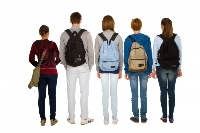
46 percent of high school students are addicted or abusing some substance, be it alcohol or drugs. Needless to say, this trend has emerged as America’s number one health problem.
Typically, substance abuse among kids begins at a young age. Studies depict that nine out of 10 addicted Americans most commonly initiated smoking, drinking or using other substances before the age of 18.
For teenagers battling substance abuse, school often acts as the trigger for a relapse. The majority of adolescents in case of residential treatment have no option but to return to their pretreatment neighborhoods and schools. One study found that virtually all adolescents returning to their old school reported being offered drugs on their first day back in school.
Students who return to their high school after treatment often find it representative of an environment of previous use and emotional turmoil. It also blatantly exposes them to old friends still using that may quickly lead to relapse.
The Birth of Recovery Schools
Nationwide, a small number of recovery high schools have emerged to combat this problem, providing a safe option for students struggling to avoid flipping into an old harmful lifestyle.
“It’s just too easy for these students to go back to using drugs and drinking at their old school,” stated Andrew J. Finch, PhD, a co-founder and former Executive Director of the Association of Recovery School. “We want to create a safe place for them so they’re not confronted by drugs and alcohol during the school day.”
The first recovery high school was established in 1987 in Minnesota. Currently, the Association of Recovery Schools a network of recovery high schools, has 35 member high schools in ten states.
“Recovery schools are a unique intervention that can help students sustain their abstinence, which in many cases can save their lives,” explained Kevin Jennings, Assistant Deputy Secretary for Safe and Drug-Free Schools at the U.S. Department of Education. “Throwing kids in recovery back into their old high schools is setting them up to fail, so we need to look for alternatives for them. We do a lot of primary prevention in this country, but the further you go down the spectrum of prevention, treatment and recovery, the less help there is.”
 Certain precursory assessments illustrate that recovering students are significantly less likely to relapse if they attend a recovery high school compared to returning to their regular school.
Certain precursory assessments illustrate that recovering students are significantly less likely to relapse if they attend a recovery high school compared to returning to their regular school.
Even though all recovery high schools are essentially founded upon similar philosophies, each school is structured and run differently based on their resources and the state they are located in.
Recovery high schools tend to be small, with an average enrollment of 30 students. As a result, students from different grades are often grouped together. A school’s approach to academics varies as the curriculum taught is influenced by the state standards, yet it’s individualized for each student depending on how much they missed out on.
The staff of recovery schools typically consists of therapists, substance abuse counselors and mental health professionals, who assist the students with co-existing disorders such as anxiety, depression or attention deficit hyperactivity disorder.
Some schools also have built-in services for students who require primary treatment. Most students, however, arrive at recovery schools after they have already been through treatment.
The biggest advantage of recovery schools is that when a student does relapse, he/she is already surrounded by peers, teachers and staff who can be helpful. Being in such an environment of recovery, students get to be more forthcoming about a relapse.
Even though schools allow students to stay longer following a relapse or two, if a pattern of dishonesty seems to emerge, the staff may recommend transition of the student to a more intense treatment or to another school altogether.
Recovery schools also help support families who are adjusting to live with a teenager in recovery. “Some studies indicate that 70 to 80 percent of students coming into a recovery school have a co-occurring disorder such as physical, sexual or mental trauma,” stated Finch. “When their alcohol and drug abuse goes away, the co-occurring trauma may become prominent and families need to make sure treatment is in place for that trauma.”
Association of Recovery Schools (ARS)
ARS has developed membership criteria for schools that wish to join the association. Recovery high schools fit each of the following criteria:

State requirements must be met for awarding a secondary school diploma. Such schools are designed specifically for students recovering from substance abuse or dependency. Academic services are provided in collaboration with assistance with recovery and continuing care.
However, they are not treatment centers or mental health agencies. All students enrolled must be in recovery and working a program of recovery determined by the student and the School.
Students receive credit towards a high school or college degree for the academic courses they undertake.
Policies and protocols are in place to address the needs of students in crisis, therapeutic or other.
These schools enlist other treatment tools as well to maintain sobriety in their students. Outdoor therapy, community work, therapeutic sessions and family therapy are usually all part of the plan.
An Emerging Prospect
A 2008 study conducted by Paul Moberg, a researcher at the University of Wisconsin Public Health Institute, and Andrew Finch, a professor at Vanderbilt University, evaluated 321 students at 17 schools and noticed a significant reduction in substance use and in mental health symptoms, including depression and anxiety.
The study further discovered that 56 percent of recovery school students were abstaining from all drugs and alcohol 90 days into the program, compared to only 20 percent abstaining 90 days before they joined the program.
The recovering youth who follow up with alternative peer groups, family support or attend a recovery school show significantly better rates of recovery. Some studies show these recovery rates to be as high as 75 percent.
Encouraged by the findings so far, the National Institutes of Health has just funded the first large study of recovery high schools.
“We hear a lot that young addicts are just kind of throwaway kids that aren’t worth the time. They’re the bad kids so you don’t want your kids around them. But we’re seeing that these are great kids with such wonderful potential,” stated Traci Bowermaster, a teacher at a recovery high school in Minneapolis. “These aren’t throwaway kids. These are kids with huge challenges to deal with who are working on a plan to get through those challenges.”
 About the Author:
About the Author:
A journalist and social media savvy content writer with wide research, print and on-air interview skills, Sana Ahmed has previously worked as staff writer for a renowned rehabilitation institute focusing on mental health and addiction recovery, a content writer for a marketing agency, an editor for a business magazine and been an on-air news broadcaster.
Sana graduated with a Bachelors in Economics and Management from London School of Economics and began a career of research and writing right after. The art of using words to educate, stir emotions, create change and provoke action is at the core of her career, as she strives to develop content and deliver news that matters.
References:
[1]: http://www.huffingtonpost.com/entry/recovery-high-schools-teen-addicts_us_561eb212e4b050c6c4a408ee
https://www.ncbi.nlm.nih.gov/pmc/articles/PMC2629137/
The opinions and views of our guest contributors are shared to provide a broad perspective of addictions. These are not necessarily the views of Addiction Hope, but an effort to offer discussion of various issues by different concerned individuals.
We at Addiction Hope understand that addictions result from a combination of environmental and genetic factors. If you or a loved one are suffering from an addiction, please know that there is hope for you, and seek immediate professional help.
Reviewed By: Jacquelyn Ekern, MS, LPC on April 9, 2017
Published on AddictionHope.com
